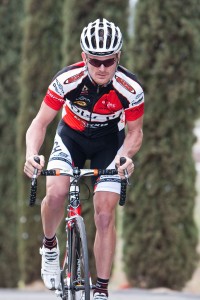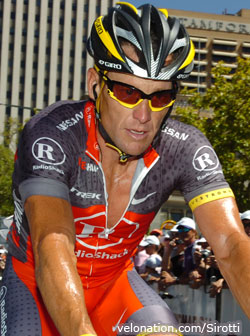Ongoing US Postal Service allegations cast shadow over Tour de France
 The spectre of past Tours threaten to dominate many of the headlines of the current race, following a substantial exposé featured in the Wall Street Journal today. The piece is mainly based around the testimony of Floyd Landis, the former team-mate of Lance Armstrong on the US Postal Service squad, who has gone into further details about what he said was a systematic doping programme within the team.
The spectre of past Tours threaten to dominate many of the headlines of the current race, following a substantial exposé featured in the Wall Street Journal today. The piece is mainly based around the testimony of Floyd Landis, the former team-mate of Lance Armstrong on the US Postal Service squad, who has gone into further details about what he said was a systematic doping programme within the team.
The latest revelations follow on from details provided to the media around the time of the Tour of California, which followed on from information Landis gave to the UCI, US Cycling, the US Anti-Doping Agency and the World Anti Doping Agency.
The chairman of the latter, David Howman, recently described the investigation into those allegations as being a ‘fruitful’ one, and appeared satisfied that there were grounds to dig deeper into how the team was run during Lance Armstrong’s winning streak.
Further Landis claims
Today’s Wall Street Journal includes a number of details, including several new allegations. The explosive claims include the following:
– Clandestine blood transfusions were given to riders during the 2004 Tour de France. These took place on July 12th in a hotel near the village of Saint-Léonard-de-Noblat, and were held in a room set up for the banned procedure. Landis says that staff members acted as security to prevent anyone walking in on the procedure, and that measures were taken to prevent the use of any hidden cameras.
On the date in question, Landis said that he, Lance Armstrong, George Hincapie and José Luis Rubiera all received transfusions. He stated that the standard method for disposing of the empty blood bags was to cut them up and flush them down the toilet, thus ensuring no evidence was left behind.
– On another occasion during the 2004 Tour, the team bus stopped on a remote alpine road and the driver pretended to have engine trouble. Over the course of about an hour, several riders received blood transfusions on the bus, including Armstrong.
– Landis’s doping use had begun after the 2002 Dauphiné Libéré, when team manager Johan Bruyneel confirmed that he would be riding the Tour de France, and told him that he should start using testosterone patches to boost his recovery. Landis said that he flew with Armstrong back to their training base in St. Moritz, and that the Texan handed him approximately 20 testosterone patches in full view of his-then wife, Kristin.
He then had blood taken out several days later by Dr. Michele Ferrari, and that this would be transfused back into his body during the Tour de France, boosting his stamina.
 – Landis was asked by Armstrong to stay in his Girona apartment at one point during the 2003 season, and to monitor blood stored in a refrigerator there. Landis said that the blood belonged to Armstrong and to Hincapie.
– Landis was asked by Armstrong to stay in his Girona apartment at one point during the 2003 season, and to monitor blood stored in a refrigerator there. Landis said that the blood belonged to Armstrong and to Hincapie.
– Landis discovered in 2004 that approximately 60 bikes supplied to the team by their sponsor Trek did not reach the riders, and were instead sold in order to fund the team’s doping programme. Trek’s general counsel Robert Burns has confirmed that some bikes were sold on the internet, and that the company was not particularly happy about it. He said that Trek did not know what the money was used for, and declined to confirm reports that Federal investigators had contacted the company.
– Several members of the team were brought by Armstrong to a strip club in Austin, Texas, in late 2001, named the Yellow Rose. The Wall Street Journal said that its general manager Don King had confirmed that Armstrong and other riders on the tem had been coming to the club for a decade. Landis said that later that night, some of the riders went to the offices of the agency that represents Mr. Armstrong, and there four strippers arrived and performed a private show for the riders. He also claimed that some of those present were snorting a substance which appeared to be cocaine.
Armstrong didn’t respond to requests for comment by the Wall Street Journal, but his lawyer Tim Herman said that “Mr. Armstrong had no contact with strippers or cocaine.”
– Landis, Levi Leipheimer and several others worked together in 2005 to co-ordinate their own doping programme, helping to ease the logistics involved.
– In 2006, Landis received support and financial backing from Phonak team owner Andy Rihs to use a blood doping programme. He later tested positive after winning the Tour de France. He claimed that following a press conference to deny his doping, he got a phone call from Armstrong where he was told to deny all knowledge of doping and not to comment any further.
Landis also said that he was encouraged to come clean by Jonathan Vaughters, another former US Postal team-mate.
The article stated that those accused all denied the claims. It also said that three former team-mates all confirmed that there was doping on the team during the time Armstrong was its lead rider. One of those admitted that he too had doped.
It has been reported that at least two riders have spoken to Federal investigators, backing up Landis’s allegations. If other witnesses have come forward, it gives greater credibility to the claims. As many have pointed out, Landis alone may have difficulty in being seen as a credible witness, due to previous denial about his own doping. With additional support, though, the investigation will gather pace.
Denial issued
As might be expected, Lance Armstrong has forcefully rubbished the latest claims. A statement issued today reads as follows:
“Today’s Wall Street Journal article is full of false accusations and more of the same old news from Floyd Landis, a person with zero credibility and an established pattern of recanting tomorrow what he swears to today. The article repeats many of Landis’ baseless and already-discredited claims against many successful people in cycling, and even includes some newly created Landis concoctions.
“Landis’ credibility is like a carton of sour milk: once you take the first sip, you don’t have to drink the rest to know it has all gone bad. For years, sensational stories – based on the allegations of ax-grinders — have surfaced on the eve of the Tour for publicity reasons, and this article is simply no different.
“Lastly, I have too much work to do during this, my final Tour, and then after my retirement in my continued fight against cancer, to add any attention to this predictable pre-Tour sensationalism.”
Tour organisers ASO have yet to react to the news, which ensures a dark cloud over the race as it begins in Rotterdam. What’s certain, though, is that Armstrong’s RadioShack team is likely to be under great scrutiny during the Tour, particularly as there is a police investigation underway in France in relation to the use of banned infusion kits at last year’s race.
Opinions are likely to remain varied for now. Armstrong’s supporters will back the Texan in believing that Landis has no credibility, while those with doubts about the USPS team will point to the extra details provided and the testimony of un-named riders. It’s clear that this issue is not going to be resolved any time soon, and that cycling is once again suffering under the spectre of doping.